
How to make sun-dried strawberry leather
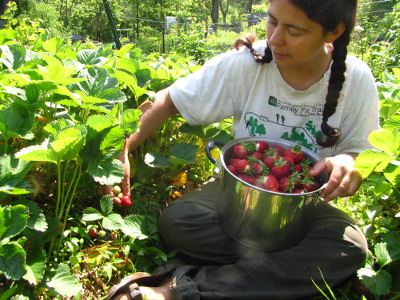 Peach
leather turned out
to be our favorite preserved fruit last year. I say "our", but
I'm ashamed to admit that I mostly ate the delicacy for my solitary
breakfasts, so Mark didn't get to enjoy the dried fruit. Once he
finally got a taste of the peach leather, it became clear that I'd
better make more this summer so that we could share from now on.
Peach
leather turned out
to be our favorite preserved fruit last year. I say "our", but
I'm ashamed to admit that I mostly ate the delicacy for my solitary
breakfasts, so Mark didn't get to enjoy the dried fruit. Once he
finally got a taste of the peach leather, it became clear that I'd
better make more this summer so that we could share from now on.
The first step in making
any kind of fruit leather is to think about supplies and dehydrator
space. Two cups of whole strawberries are going to turn into
about a cup and a quarter of fruit puree, which in turn will fill up
one medium-sized cookie sheet. Don't pick more fruit than you
have room for, or you'll just have to gorge on the excess for
supper. (Our life is so hard....)
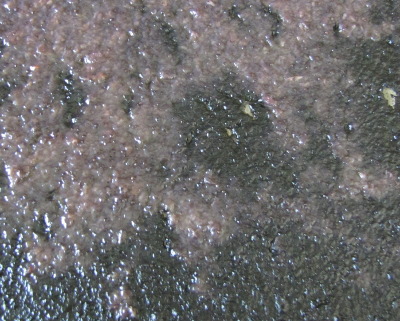
Next, check the weather
forecast. If you're relying on sunshine to dehydrate your fruit,
you'd better find at least a day and a half of hot, sunny
weather. Don't start your leather on a sunny afternoon if it's
slated to rain the next day, or your fruit will go bad. If the
leather turns gray (like this), starts to smell, or gets moldy, you'll
have to throw it out. To be on the safe side, it's best to always
start fruit leather first thing in the morning.
With all of those
preparations out of the way, it's actually very simple to make
strawberry 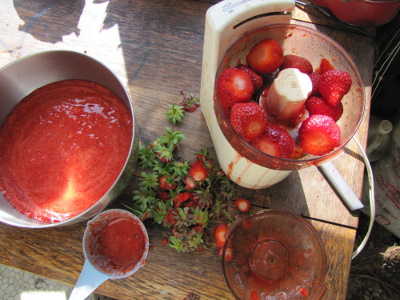 leather. Rinse your
fruits if they're truly dirty (or came from someone else's place), then
cut off the tops and turn the strawberries into puree in the food
processor. Measure how much puree you have and add 1 tablespoon
of honey and 0.5 tablespoons of lemon juice per cup --- the honey
sweetens your fruit and also helps the leather stick together while the
lemon juice preserves color and kills microorganisms.
leather. Rinse your
fruits if they're truly dirty (or came from someone else's place), then
cut off the tops and turn the strawberries into puree in the food
processor. Measure how much puree you have and add 1 tablespoon
of honey and 0.5 tablespoons of lemon juice per cup --- the honey
sweetens your fruit and also helps the leather stick together while the
lemon juice preserves color and kills microorganisms.
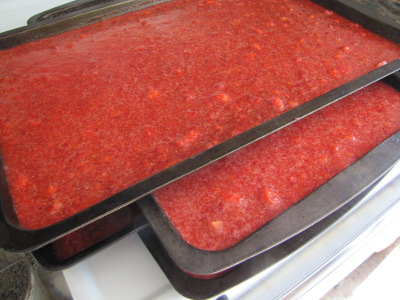 Pour about a cup and a
quarter of doctored puree into each cookie sheet and tilt the pan until
the fruit evenly covers the surface. This will make a paper-thin
leather, which is what's called for with solar dehydrating since the
thin layer of fruit will dry in a day or two. If I was running an
electric dehydrator, I might use two or even three cups of puree per
tray to make a thick leather like you'll find in the store.
Pour about a cup and a
quarter of doctored puree into each cookie sheet and tilt the pan until
the fruit evenly covers the surface. This will make a paper-thin
leather, which is what's called for with solar dehydrating since the
thin layer of fruit will dry in a day or two. If I was running an
electric dehydrator, I might use two or even three cups of puree per
tray to make a thick leather like you'll find in the store.
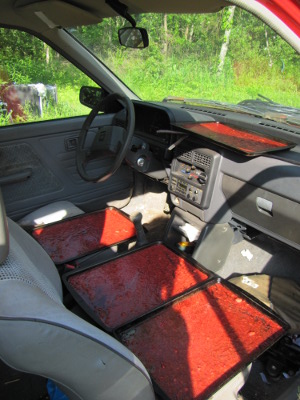 Stack your trays as shown
above and you can carry up to five trays at once as you head out to
your hot, dry spot. It's possible to simply dehydrate fruit
outside in the sun, but the process will take longer and you'll have to
cover the leather with a screen to keep out bugs while letting water
escape. Mark wishes I would let him make me a real solar
dehydrator (one of
these days!), but in the meantime we're using the parts Festiva to dry out fruit. Any
location where the temperature gets between 100 and 140 degrees
Fahrenheit will work; higher temperatures will cook your fruit rather
than drying it, reducing nutrients and flavor, while lower temperatures
won't dry the fruit before it goes bad.
Stack your trays as shown
above and you can carry up to five trays at once as you head out to
your hot, dry spot. It's possible to simply dehydrate fruit
outside in the sun, but the process will take longer and you'll have to
cover the leather with a screen to keep out bugs while letting water
escape. Mark wishes I would let him make me a real solar
dehydrator (one of
these days!), but in the meantime we're using the parts Festiva to dry out fruit. Any
location where the temperature gets between 100 and 140 degrees
Fahrenheit will work; higher temperatures will cook your fruit rather
than drying it, reducing nutrients and flavor, while lower temperatures
won't dry the fruit before it goes bad.
If you're using a
ramshackle dehydrator like ours, you'll want to check on your leather
two or three times a day, moving wetter trays into the sunniest spots
and removing finished trays. I discovered by accident that if you
leave finished trays in the car overnight, just enough moisture will
seep back into the leather that it will peel off the tray with
ease. Of course, real people use Saran wrap underneath the fruit
so that they don't have to pry it loose, but since I don't care about
appearances, I ditch the disposables.
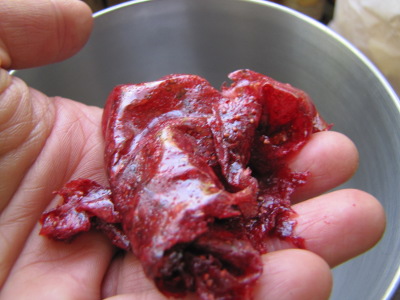 You can store dried fruit on
the shelf for a few weeks, in the fridge for a few months, or just toss
it in the freezer like we do. Since around half a gallon of
strawberries turns into about a cup of fruit leather, space in the
freezer won't be a problem. The real trouble will be keeping your
fingers out of this natural, vitamin-rich candy until the cold season
rolls back around.
You can store dried fruit on
the shelf for a few weeks, in the fridge for a few months, or just toss
it in the freezer like we do. Since around half a gallon of
strawberries turns into about a cup of fruit leather, space in the
freezer won't be a problem. The real trouble will be keeping your
fingers out of this natural, vitamin-rich candy until the cold season
rolls back around.
Want more in-depth information? Browse through our books.
Or explore more posts by date or by subject.
About us: Anna Hess and Mark Hamilton spent over a decade living self-sufficiently in the mountains of Virginia before moving north to start over from scratch in the foothills of Ohio. They've experimented with permaculture, no-till gardening, trailersteading, home-based microbusinesses and much more, writing about their adventures in both blogs and books.
Want to be notified when new comments are posted on this page? Click on the RSS button after you add a comment to subscribe to the comment feed, or simply check the box beside "email replies to me" while writing your comment.

You might go ahead and give it a try with any fruits you have in excess. I'm already pondering running raspberries (due to ripen in a couple of weeks) through the foley mill and then drying the juice, and doing the same with the grapes that look like they'll be here in abundance this fall. Just tweak the lemon and honey a bit and use the same recipe.
I'm totally in love with homemade fruit leather now. And it's really pretty easy! We already have a quart in the freezer and the fixings of perhaps another quart in the "dehydrator."